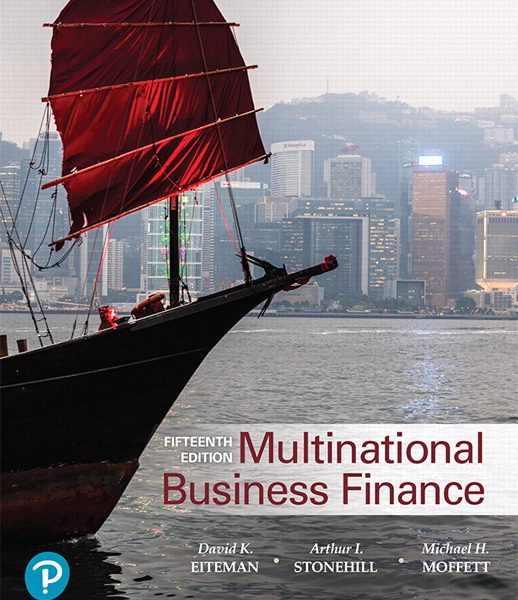This is completed downloadable of Test bank for Multinational Business Finance 15th by Eiteman

Product Details:
- ISBN-10 : 0134796551
- ISBN-13 : 978-0134796550
- Author:
Renowned for its authoritative, comprehensive coverage of contemporary international finance, Multinational Business Finance trains the leaders of tomorrow’s multinational enterprises to recognize and capitalize on the unique characteristics of global markets. Because the job of a manager is to make financial decisions that increase a firm’s value, the authors have embedded real-world mini-cases throughout to apply chapter concepts to the types of situations managers of multinational firms face. The 15th Edition attempts to capture the rapid evolution of our global marketplace, taking a closer look at the types of organizations that permeate the widespread arena, competition and opportunities in emerging markets, and how financial leadership can integrate the strategic and financial challenges that global businesses face today.
Table of Content:
- PART ONE Global Financial Environment
- Chapter 1 Multinational Financial Management: Opportunities and Challenges
- LEARNING OBJECTIVES
- 1.1 The Global Financial Marketplace
- Assets, Institutions, and Linkages
- Securities
- Institutions
- Linkages
- The Market for Currencies
- Currency Symbols
- Exchange Rate Quotations and Terminology
- Quotation Conventions
- Financial Globalization and Risk
- Eurocurrencies and Eurocurrency Interest Rates
- Eurocurrencies
- Eurocurrency Interest Rates
- 1.2 The Theory of Comparative Advantage
- 1.3 What Is Different about International Financial Management?
- Market Imperfections: A Rationale for the Existence of the Multinational Firm
- Why Do Firms Go Global?
- You the Professional and Multinational Financial Management
- 1.4 The Globalization Process
- Global Transition I: Domestic Phase to the International Trade Phase
- Global Transition II: The International Trade Phase to the Multinational Phase
- The Multinational Enterprise’s Consolidated Financial Results
- The Limits to Financial Globalization
- Summary Points
- Questions
- Problems
- Internet Exercises
- Chapter 2 The International Monetary System
- LEARNING OBJECTIVES
- 2.1 History of the International Monetary System
- The Gold Standard (1876–1913)
- The Interwar Years and World War II (1914–1944)
- Bretton Woods and the International Monetary Fund (1944)
- Fixed Exchange Rates (1945–1973)
- The Floating Exchange Rates, 1973–1997
- The Emerging Era, 1997–Present
- IMF Classification of Currency Regimes
- Brief Classification History
- The IMF’s de facto System
- Category 1: Hard Pegs
- Category 2: Soft Pegs
- Category 3: Floating Arrangements
- Category 4: Residual
- A Global Eclectic
- 2.2 Fixed Versus Flexible Exchange Rates
- 2.3 The Impossible Trinity
- 2.4 A Single Currency for Europe: The Euro
- The Maastricht Treaty and Monetary Union
- The European Central Bank (ECB)
- The Launch of the Euro
- 2.5 Emerging Markets and Regime Choices
- Currency Boards
- Argentina
- Dollarization
- Ecuador
- Currency Regime Choices for Emerging Markets
- Exchange Rate Regimes: What Lies Ahead?
- Summary Points
- Questions
- Problems
- Internet Exercises
- Chapter 3 The Balance of Payments
- LEARNING OBJECTIVES
- 3.1 Fundamentals of BOP Accounting
- Defining International Economic Transactions
- The BOP as a Flow Statement
- BOP Accounting
- 3.2 The Accounts of the Balance of Payments
- The Current Account
- The Capital and Financial Accounts
- Financial Account
- Direct Investment
- Portfolio Investment
- Other Asset Investment
- Net Errors and Omissions and Official Reserves Accounts
- Net Errors and Omissions Account
- Official Reserves Account
- Breaking the Rules: China’s Twin Surpluses
- 3.3 BOP Impacts on Key Macroeconomic Rates
- The BOP and Exchange Rates
- Fixed Exchange Rate Countries
- Floating Exchange Rate Countries
- Managed Floats
- The BOP and Interest Rates
- The BOP and Inflation Rates
- 3.4 Trade Balances and Exchange Rates
- Trade and Devaluation
- The J-Curve Adjustment Path
- Trade Balance Adjustment Path: The Equation
- 3.5 Capital Mobility
- Current Account Versus Financial Account Capital Flows
- Historical Patterns of Capital Mobility
- Classical Gold Standard (1870–1914)
- Interwar Years (1923–1938)
- Fixed Exchange Rates (1944–1973)
- Floating Exchange Rates (1973–1997)
- The Emerging Era (1997–Present)
- Capital Controls
- Globalization of Capital Flows
- Summary Points
- Questions
- Problems
- Internet Exercises
- Chapter 4 Financial Goals and Corporate Governance
- LEARNING OBJECTIVES
- 4.1 Business Ownership
- Types of Ownership
- Business Ownership
- Separation of Ownership from Management
- The Goal of Management
- Shareholder Capitalism
- Agency Theory
- Long-Term Versus Short-Term Value Maximization
- Stakeholder Capitalism
- Market Efficiency
- Risk
- Single Versus Multiple Goals
- The Scorecard
- Operational Goals
- Returns to Investors in Publicly Traded Firms
- Returns to Owners of Privately Held Firms
- Operational Goals for MNEs
- Consolidated Profits
- Public/Private Hybrids
- 4.2 Publicly Traded Versus Privately Held: The Global Shift
- Listings Measurement
- Listing Additions
- Delistings
- Possible Causes in the Decline of Publicly Traded Shares
- 4.3 Corporate Governance
- The Goal of Corporate Governance
- The Structure of Corporate Governance
- Board of Directors
- Management
- Equity Markets
- Debt Markets
- Auditors and Legal Advisers
- Regulators
- Comparative Corporate Governance
- Financial Market Development
- Separation of Management and Ownership
- Disclosure and Transparency
- Historical Development of the Legal System
- Family Ownership and Corporate Governance
- Failures in Corporate Governance
- Good Governance and Corporate Reputation
- Corporate Governance Reform
- Sarbanes-Oxley Act
- Corporate Responsibility and Sustainability
- Summary Points
- Questions
- Problems
- Internet Exercises
- PART TWO Foreign Exchange Theory and Markets
- Chapter 5 The Foreign Exchange Market
- LEARNING OBJECTIVES
- 5.1 Functions of the Foreign Exchange Market
- 5.2 Structure of the Foreign Exchange Market
- The Global Trading Day
- Market Participants—The Players
- Bank and Nonbank Dealers
- Commercial and Investment Transactors
- Speculators and Arbitragers
- Central Banks and Treasuries
- Foreign Exchange Brokers
- Evolution of the Market
- The Evolution of FX Trading
- 1985
- 1990s
- 2010
- The Three Components of FX Trades
- FX Market Manipulation: Fixing the Fix
- 5.3 Transactions in the Foreign Exchange Market
- Spot Transactions
- Forward Transactions
- Swap Transactions
- Spot Against Forward
- Forward-Forward Swaps
- Nondeliverable Forwards (NDFs)
- Size of the Foreign Exchange Market
- Geographical Distribution
- Currency Composition
- 5.4 Foreign Exchange Rates and Quotations
- Currency Symbols
- Exchange Rate Quotes
- Market Conventions
- European Terms
- American Terms
- Currency Nicknames
- Direct and Indirect Quotations
- Bid and Ask Rates
- Cross Rates
- Intermarket Arbitrage
- Forward Quotations
- Summary Points
- Questions
- Problems
- Internet Exercises
- Chapter 6 International Parity Conditions
- LEARNING OBJECTIVES
- 6.1 Prices and Exchange Rates
- Purchasing Power Parity and the Law of One Price
- Relative Purchasing Power Parity
- Empirical Tests of Purchasing Power Parity
- Exchange Rate Indices: Real and Nominal
- Exchange Rate Pass-Through
- Complete Versus Partial Pass-Through
- Price Elasticity of Demand
- Pass-Through and Emerging Market Currencies
- 6.2 Interest Rates and Exchange Rates
- The Fisher Effect
- The International Fisher Effect
- The Forward Rate
- Calculation of Forward Premiums
- Foreign Currency Terms
- Interest Rate Parity (IRP)
- Covered Interest Arbitrage (CIA)
- Rule of Thumb
- Arbitrage Rule of Thumb:
- Uncovered Interest Arbitrage (UIA)
- Equilibrium Between Interest Rates and Exchange Rates
- 6.3 Forward Rate as an Unbiased Predictor of the Future Spot Rate
- 6.4 Prices, Interest Rates, and Exchange Rates in Equilibrium
- Summary Points
- Questions
- Problems
- Internet Exercises
- Chapter 6 Appendix An Algebraic Primer to International Parity Conditions
- The Law of One Price
- Purchasing Power Parity
- Forward Rates
- Covered Interest Arbitrage (CIA) and Interest Rate Parity (IRP)
- Fisher Effect
- International Fisher Effect
- Chapter 7 Foreign Currency Derivatives: Futures and Options
- LEARNING OBJECTIVES
- 7.1 Foreign Currency Futures
- Contract Specifications
- Using Foreign Currency Futures
- Short Positions
- Long Positions
- Foreign Currency Futures Versus Forward Contracts
- 7.2 Foreign Currency Options
- Option Fundamentals
- Foreign Currency Options Markets
- Options on the Over-the-Counter Market
- Options on Organized Exchanges
- Currency Option Quotations and Prices
- Buyer of a Call
- Writer of a Call
- Buyer of a Put
- Writer of a Put
- 7.3 Option Pricing and Valuation
- 7.4 Currency Option Pricing Sensitivity
- Forward Rate Sensitivity
- Spot Rate Sensitivity (delta)
- Time to Maturity: Value and Deterioration (theta)
- Sensitivity to Volatility (lambda)
- Historic Volatility
- Forward-Looking Volatility
- Implied Volatility
- Sensitivity to Changing Interest Rate Differentials (rho and phi)
- Alternative Strike Prices and Option Premiums
- Prudence in Practice
- Summary Points
- Questions
- Problems
- Pricing Your Own Options
- Internet Exercises
- Chapter 7 Appendix Currency Option Pricing Theory
- The European Call Option: Numerical Example
- Chapter 8 Interest Rate Risk and Swaps
- LEARNING OBJECTIVES
- 8.1 Interest Rate Foundations
- Interest Rate Calculations
- The Reference Rate: LIBOR
- 8.2 The Cost of Debt
- Credit Ratings and Cost of Funds
- Credit Risk and Repricing Risk
- Sovereign Debt
- Sovereign Spreads
- European Sovereign Debt
- 8.3 Interest Rate Risk
- Debt Structures and Strategies
- An Illustration: MedStat’s Floating-Rate Loans
- 8.4 Interest Rate Futures and FRAs
- Interest Rate Futures
- Forward Rate Agreements
- 8.5 Interest Rate Swaps
- Swap Structures
- Illustrative Case: MedStat’s Floating-Rate Debt
- Plain-Vanilla Swap Strategies
- Debt Structure
- Debt Cost
- Cross-Currency Swaps
- Illustrative Case: MedStat Uses a Cross-Currency Swap
- Illustrative Case: MedStat Unwinds a Currency Swap
- Counterparty Risk
- Summary Points
- Questions
- Problems
- Internet Exercises
- Chapter 9 Foreign Exchange Rate Determination and Intervention
- LEARNING OBJECTIVES
- 9.1 Exchange Rate Determination: The Theoretical Thread
- Parity Conditions Approach
- Balance of Payments Approach
- Monetary Approach and Asset Market Approach
- Monetary Approach
- Asset Market Approach
- The Asset Market Approach to Forecasting
- 9.2 Currency Market Intervention
- Motivations for Currency Market Intervention
- Intervention Methods
- Direct Intervention
- Indirect Intervention
- Capital Controls
- When Foreign Currency Intervention Fails
- Turkey 2014
- Japan 2010
- 9.3 Disequilibrium: Exchange Rates in Emerging Markets
- The Asian Financial Crisis of 1997
- Crisis
- Causal Complexities
- The Argentine Crisis of 2002
- Economic Crisis
- Devaluation
- 9.4 Currency Forecasting in Practice
- Technical Analysis
- Cross-Rate Consistency in Forecasting
- Forecasting: What to Think?
- Exchange Rate Dynamics: Making Sense of Market Movements
- Summary Points
- Questions
- Problems
- Russo-Swiss Cross—2015
- Internet Exercises
- PART THREE Foreign Exchange Exposure
- Chapter 10 Transaction Exposure
- LEARNING OBJECTIVES
- 10.1 Types of Foreign Exchange Exposure
- 10.2 Why Hedge?
- Hedging Defined
- The Pros and Cons of Hedging
- Pros
- Cons
- 10.3 Transaction Exposure
- Purchasing and Selling
- Borrowing and Lending
- Other Causes of Transaction Exposure
- 10.4 Transaction Exposure Management
- Ganado’s Transaction Exposure
- Unhedged Position
- Forward Hedge
- Money Market Hedge (Balance Sheet Hedge)
- Forward and Money Market Hedges Compared
- Options Market Hedge
- Hedging Alternatives Compared
- Hedging an Account Payable
- Remain Unhedged
- Forward Market Hedge
- Money Market Hedge
- Option Hedge
- Strategy Choice
- 10.5 Transaction Exposure Management in Practice
- Which Goals
- Which Transaction Exposures
- What Levels of Exposure Cover
- Which Hedging Instruments and Structures
- Summary Points
- Questions
- Problems
- Internet Exercises
- Chapter 10 Appendix A Complex Option Hedges
- The Synthetic Forward
- Second-Generation Currency Risk Management Products
- Zero-Premium Option Products
- The Range Forward or Collar
- The Participating Forward
- Ratio Spreads
- The Average Rate Option
- Chapter 10 Appendix B The Optimal Hedge Ratio and Hedge Effectiveness
- Hedge Ratio
- Hedge Symmetry.
- Hedge Effectiveness.
- Hedge Timing.
- Chapter 11 Translation Exposure
- LEARNING OBJECTIVES
- 11.1 Overview of Translation
- Concepts and Definitions
- Reporting Currency
- Foreign Entity
- Distinct and Separable Operation
- Functional Currency
- Foreign Currency Financial Statements
- Remeasurement and Translation
- Foreign Currency Measurement (Remeasurement)
- Foreign Currency Translation
- 11.2 Translation Methods
- Current Rate Method
- Temporal Method
- U.S. Translation Procedures
- International Translation Practices
- 11.3 Ganado Corporation’s Translation Exposure
- Translation Exposure: Income
- Consolidated Sales
- Consolidated Earnings
- Translation Exposure: Balance Sheet
- Current Rate Method
- Temporal Method
- 11.4 Managing Translation Exposure
- Subsidiary Earnings
- Net Equity Investment
- Current Rate Method
- Temporal Method
- When Is a Balance Sheet Hedge Justified?
- An Illustration of Using Swaps to Hedge Translation: McDonald’s
- Hoover Hedges
- McDonald’s Business Forms
- The British Subsidiary and Currency Exposure
- Cross-Currency Swap Hedging
- Summary Points
- Questions
- Problems
- Internet Exercises
- Chapter 12 Operating Exposure
- LEARNING OBJECTIVES
- 12.1 A Multinational’s Operating Exposure
- Static Versus Dynamic Operating Exposure
- Ganado China
- Ganado Germany
- Ganado U.S
- Operating and Financing Cash Flows
- Expected Versus Unexpected Changes in Cash Flow
- Measuring Operating Exposure
- Short Run
- Medium Run: Equilibrium
- Medium Run: Disequilibrium
- Long Run
- 12.2 Measuring Operating Exposure: Ganado Germany
- The Base Case
- Case 1: Depreciation—All Variables Remain Constant
- Case 2: Volume Increases—Other Variables Remain Constant
- Case 3: Sales Price Increases—Other Variables Remain Constant
- Case 4: Price, Cost, and Volume Increases
- Other Possibilities
- Measurement of Loss
- 12.3 Strategic Management of Operating Exposure
- Diversifying Operations
- Diversifying Financing
- 12.4 Proactive Management of Operating Exposure
- Matching Currency Cash Flows
- Risk-Sharing Agreements
- Back-to-Back or Parallel Loans
- Cross-Currency Swaps
- Contractual Approaches: Hedging the Unhedgeable
- Summary Points
- Questions
- Problems
- Internet Exercises
- PART FOUR Financing the Global Firm
- Chapter 13 Global Cost and Availability of Capital
- LEARNING OBJECTIVES
- 13.1 Financial Globalization and Strategy
- Cost of Capital
- Cost of Equity
- Cost of Debt
- 13.2 International Portfolio Theory and Diversification
- Portfolio Risk Reduction
- Foreign Exchange Risk
- International CAPM (ICAPM)
- Sample Calculation: Ganado’s Cost of Capital
- ICAPM Considerations
- Global Betas
- Equity Risk Premiums
- 13.3 The Role of International Portfolio Investors
- The Link Between Cost and Availability of Capital
- Improving Market Liquidity
- Market Segmentation
- The Effect of Market Liquidity and Segmentation
- Globalization of Securities Markets
- 13.4 The Cost of Capital for MNEs Compared to Domestic Firms
- Availability of Capital
- Financial Structure, Systematic Risk, and the Cost of Capital for MNEs
- The Paradox: Is the Cost of Capital Higher for MNEs?
- 13.5 Illustrative Case: Novo Industri A/S (Novo)8
- Asymmetric Information
- Taxation
- Feasible Portfolios
- Financial, Foreign Exchange, and Political Risks
- The Road to Globalization
- Closing the Information Gap
- The Biotechnology Boom
- Directed Share Issue in the United States
- Stock Market Reactions
- Effect on Novo’s Weighted Average Cost of Capital
- Globalization of Securities Markets
- Summary Points
- Questions
- Problems
- Internet Exercises
- Chapter 14 Funding the Multinational Firm
- LEARNING OBJECTIVES
- 14.1 Designing a Strategy to Source Capital Globally
- Alternative Paths to Globalize the Cost and Availability of Capital
- 14.2 Optimal Financial Structure
- Optimal Financial Structure and the Multinational
- Availability of Capital
- Diversification of Cash Flows
- Foreign Exchange Risk and the Cost of Debt
- Expectations of International Portfolio Investors
- 14.3 Raising Equity Globally
- Initial Public Offering (IPO)
- Euroequity Issue
- Directed Public/Private Issue
- 14.4 Depositary Receipts
- ADR Mechanics
- ADR Program Structures
- DR Markets Today: Who, What, and Where
- The Who
- The What
- The Where
- Global Registered Shares (GRSs)
- 14.5 Private Placement
- SEC Rule 144A
- Private Equity Funds
- Foreign Equity Listing and Issuance
- 14.6 Raising Debt Globally
- International Debt Instruments
- Unique Characteristics of Eurobond Markets
- Absence of Regulatory Interference
- Less Stringent Disclosure
- Favorable Tax Treatment
- Ratings
- 14.7 Financing Foreign Subsidiaries
- Internal and External Subsidiary Financing
- Host Country Norms and Debt
- Foreign Exchange Concerns
- Tax Concerns
- Subsidiary Financing Over Time
- Startup Stage
- Growth Stage
- Maturing Stage
- Summary Points
- Questions
- Problems
- Internet Exercises
- Chapter 15 Multinational Tax Management
- LEARNING OBJECTIVES
- 15.1 Tax Principles and Practices
- Tax Morality
- Tax Neutrality
- National Tax Environments
- Worldwide Approach
- Territorial Approach
- Tax Deferral
- Tax Treaties
- Controlled Foreign Corporations
- Tax Types
- Direct Taxes
- Indirect Taxes
- 15.2 Multinational Tax Management
- Allocation of Debt and Earnings Stripping
- Foreign Tax Credits and Deferral
- Transfer Pricing
- Fund Positioning Effect
- Income Tax Effect
- Managerial Incentives and Evaluation
- Effect on Joint-Venture Partners
- Cross-Crediting
- Check-the-Box and Hybrid Entities
- Tax Havens and International Offshore Financial Centers
- Basis Erosion and Profit Shifting (BEPS)
- Corporate Inversion
- Substantial Business Presence
- Merger with a Larger Foreign Firm
- Merger with a Smaller Foreign Firm
- 15.3 Google: An Illustrative Case of Profit Repositioning
- 15.4 Global Tax Competitiveness
- The Digital Economy
- Country Tax Competitiveness
- Governments and Tax Sources
- 15.5 U.S. Tax Law Change in 2017
- Summary Points
- Questions
- Problems
- Internet Exercises
- Chapter 16 International Trade Finance
- LEARNING OBJECTIVES
- 16.1 The Trade Relationship
- Benefits of the System
- Protection Against Risk of Noncompletion
- Protection Against Foreign Exchange Risk
- Financing the Trade
- Noncompletion Risks
- 16.2 Key Documents
- Letter of Credit (L/C)
- Parties to a Letter of Credit (L/C)
- Irrevocable Versus Revocable L/C
- Confirmed Versus Unconfirmed L/C
- Advantages and Disadvantages of L/Cs
- Draft
- Negotiable Instruments
- Types of Drafts
- Bankers’ Acceptances
- Bill of Lading (B/L)
- Documentation in a Typical Trade Transaction
- 16.3 Government Programs to Help Finance Exports
- Export Credit Insurance
- Export-Import Bank and Export Financing
- 16.4 Trade Financing Alternatives
- Bankers’ Acceptances
- Trade Acceptances
- Factoring
- Securitization
- Bank Credit Lines
- Commercial Paper
- 16.5 Forfaiting
- Role of the Forfaiter
- A Typical Forfaiting Transaction
- Summary Points
- Questions
- Problems
- Internet Exercises
- PART FIVE Foreign Investments and Investment Analysis
- Chapter 17 Foreign Direct Investment and Political Risk
- LEARNING OBJECTIVES
- 17.1 The Foreign Direct Investment Decision
- 17.2 Structural Choices for Foreign Market Entry
- Selecting Target Markets
- The Behavioral Approach to FDI
- MNEs in a Network Perspective
- Choosing Entry Structures
- Exporting Versus Production Abroad
- Licensing and Management Contracts
- Joint Venture Versus Wholly Owned Subsidiary
- Greenfield Investments and Foreign Acquisitions
- Strategic Alliances
- 17.3 Political Risk: Definition and Classification
- 17.4 Financial Impacts of Political Risk
- Category 1: Losses in Operating Profitability
- Adverse Regulatory Change
- Breach of Contract
- Local Content Requirements
- Category 2: Transfer and Convertibility Risk
- Category 3: Expropriation and Nationalization
- Direct Versus Indirect
- Compensation
- 17.5 Political Risk Mitigation
- Stakeholder Engagement
- Use of Domestic Partners
- International Investment Agreements
- Gradual Investing
- Blocked Funds Management
- Dispute Resolution
- Political Risk Insurance
- Providers
- Multinational Use
- Summary Points
- Questions
- Internet Exercises
- Chapter 18 Multinational Capital Budgeting and Cross-Border Acquisitions
- LEARNING OBJECTIVES
- 18.1 Complexities of Budgeting for a Foreign Project
- Cash Flows
- Management Expectations
- Project Versus Parent Valuation
- 18.2 Illustrative Case: Cemex Enters Indonesia2
- Overview
- Capital Investment
- Financing
- Revenues
- Costs
- Project Viewpoint Capital Budget
- Parent Viewpoint Capital Budget
- Sensitivity Analysis: Project Viewpoint
- Political Risk
- Foreign Exchange Risk
- Other Sensitivity Variables
- Sensitivity Analysis: Parent Viewpoint
- Adjusting Discount Rates
- Adjusting Cash Flows
- Shortcomings of Each Method
- Repercussions to the Investor
- MNE Practices
- Portfolio Risk Measurement
- 18.3 Real Option Analysis
- 18.4 Project Financing
- Separability of the Project from Its Investors
- Long-Lived and Capital-Intensive Singular Projects
- Cash Flow Predictability from Third-Party Commitments
- Finite Projects with Finite Lives
- 18.5 Cross-Border Mergers and Acquisitions
- The Cross-Border Acquisition Process
- Stage 1: Identification and Valuation
- Stage 2: Completion of the Ownership Change
- Stage 3: Post-Acquisition Transition Management
- Currency Risks in Cross-Border Acquisitions
- Summary Points
- Questions
- Problems
- Internet Exercises
- Answers to Selected End-of-Chapter Problems
- Chapter 1: Multinational Financial Management: Opportunities and Challenges
- Chapter 2: International Monetary System
- Chapter 3: The Balance of Payments
- Chapter 4: Financial Goals and Corporate Governance
- Chapter 5: The Foreign Exchange Market
- Chapter 6: International Parity Conditions
- Chapter 7: Foreign Currency Derivatives: Futures and Options
- Chapter 8: Interest Rate Risk and Swaps
- Chapter 9: Foreign Exchange Rate Determination and Intervention
- Chapter 10: Transaction Exposure
- Chapter 11: Translation Exposure
- Chapter 12: Operating Exposure
- Chapter 13: Global Cost and Availability of Capital
- Chapter 14: Funding the Multinational Firm
- Chapter 15: Multinational Tax Management
- Chapter 16: International Trade Finance
- Chapter 17: Foreign Direct Investment and Political Risk
- Chapter 18: Multinational Capital Budgeting and Cross-Border Acquisitions
- Glossary
- Index





